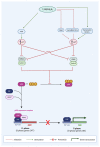Policing Cancer: Vitamin D Arrests the Cell Cycle
- PMID: 33291213
- PMCID: PMC7731034
- DOI: 10.3390/ijms21239296
Policing Cancer: Vitamin D Arrests the Cell Cycle
Abstract
Vitamin D is a steroid hormone crucial for bone mineral metabolism. In addition, vitamin D has pleiotropic actions in the body, including anti-cancer actions. These anti-cancer properties observed within in vitro studies frequently report the reduction of cell proliferation by interruption of the cell cycle by the direct alteration of cell cycle regulators which induce cell cycle arrest. The most recurrent reported mode of cell cycle arrest by vitamin D is at the G1/G0 phase of the cell cycle. This arrest is mediated by p21 and p27 upregulation, which results in suppression of cyclin D and E activity which leads to G1/G0 arrest. In addition, vitamin D treatments within in vitro cell lines have observed a reduced C-MYC expression and increased retinoblastoma protein levels that also result in G1/G0 arrest. In contrast, G2/M arrest is reported rarely within in vitro studies, and the mechanisms of this arrest are poorly described. Although the relationship of epigenetics on vitamin D metabolism is acknowledged, studies exploring a direct relationship to cell cycle perturbation is limited. In this review, we examine in vitro evidence of vitamin D and vitamin D metabolites directly influencing cell cycle regulators and inducing cell cycle arrest in cancer cell lines.
Keywords: anti-proliferation; calcitriol; cancer; cell cycle; cell proliferation; cyclin-dependent kinase; cyclin-dependent kinase inhibitor; vitamin D.
Conflict of interest statement
The authors declare no conflict of interest.
Figures


Similar articles
-
1,25(OH)2 vitamin D3 induces elevated expression of the cell cycle-regulating genes P21 and P27 in squamous carcinoma cell lines of the head and neck.Acta Otolaryngol. 2001 Jan;121(1):103-9. doi: 10.1080/000164801300006353. Acta Otolaryngol. 2001. PMID: 11270487
-
Induction of p21/WAF1 and G1 cell-cycle arrest by the chemopreventive agent apigenin.Mol Carcinog. 1997 Jun;19(2):74-82. doi: 10.1002/(sici)1098-2744(199707)19:2<74::aid-mc2>3.0.co;2-l. Mol Carcinog. 1997. PMID: 9210954
-
Inhibition of MG-63 cell cycle progression by synthetic vitamin D3 analogs mediated by p27, Cdk2, cyclin E, and the retinoblastoma protein.Biochem Pharmacol. 2003 Aug 1;66(3):495-504. doi: 10.1016/s0006-2952(03)00283-1. Biochem Pharmacol. 2003. PMID: 12907249
-
[Molecular mechanisms controlling the cell cycle: fundamental aspects and implications for oncology].Cancer Radiother. 2001 Apr;5(2):109-29. doi: 10.1016/s1278-3218(01)00087-7. Cancer Radiother. 2001. PMID: 11355576 Review. French.
-
Cyclins and CDKS in development and cancer: lessons from genetically modified mice.Front Biosci. 2006 Jan 1;11:1164-88. doi: 10.2741/1871. Front Biosci. 2006. PMID: 16146805 Review.
Cited by
-
Vitamin D Receptor Expression and its Clinical Significance in Papillary Thyroid Cancer.Technol Cancer Res Treat. 2022 Jan-Dec;21:15330338221089933. doi: 10.1177/15330338221089933. Technol Cancer Res Treat. 2022. PMID: 35379049 Free PMC article.
-
25-Hydroxycholecalciferol Serum Level Shows an Inverse Relationship with High-Grade Uterine Cervical Dysplasia in HIV-Uninfected Black Women in South Africa.J Clin Med. 2025 May 29;14(11):3817. doi: 10.3390/jcm14113817. J Clin Med. 2025. PMID: 40507578 Free PMC article.
-
Metabolic Classification and Intervention Opportunities for Tumor Energy Dysfunction.Metabolites. 2021 Apr 23;11(5):264. doi: 10.3390/metabo11050264. Metabolites. 2021. PMID: 33922558 Free PMC article. Review.
-
Neuroprotective Effect of 1,4-Naphthoquinones in an In Vitro Model of Paraquat and 6-OHDA-Induced Neurotoxicity.Int J Mol Sci. 2021 Sep 14;22(18):9933. doi: 10.3390/ijms22189933. Int J Mol Sci. 2021. PMID: 34576094 Free PMC article.
-
Role of Vitamin D in Head and Neck Cancer-Immune Function, Anti-Tumour Effect, and Its Impact on Patient Prognosis.Nutrients. 2023 May 31;15(11):2592. doi: 10.3390/nu15112592. Nutrients. 2023. PMID: 37299554 Free PMC article. Review.
References
Publication types
MeSH terms
Substances
Grants and funding
LinkOut - more resources
Full Text Sources
Medical

